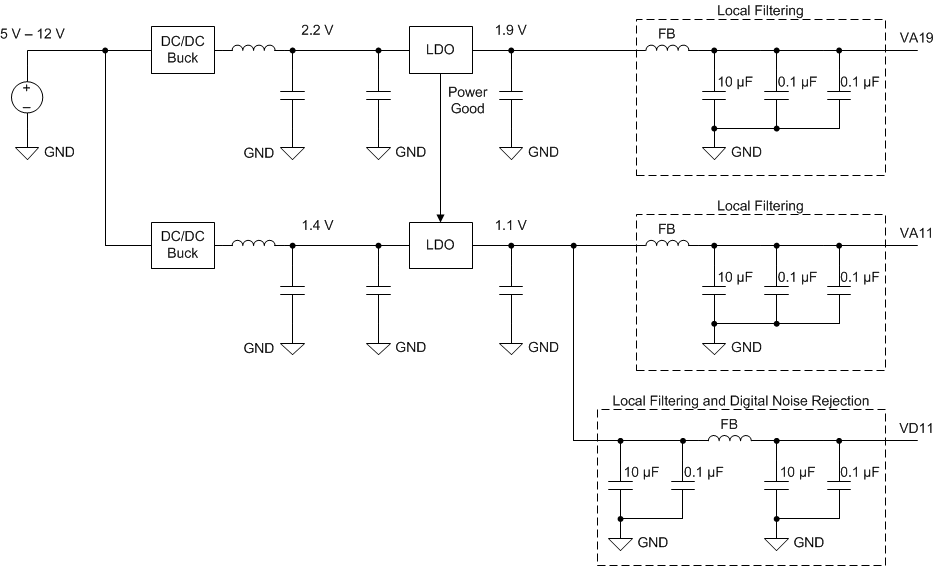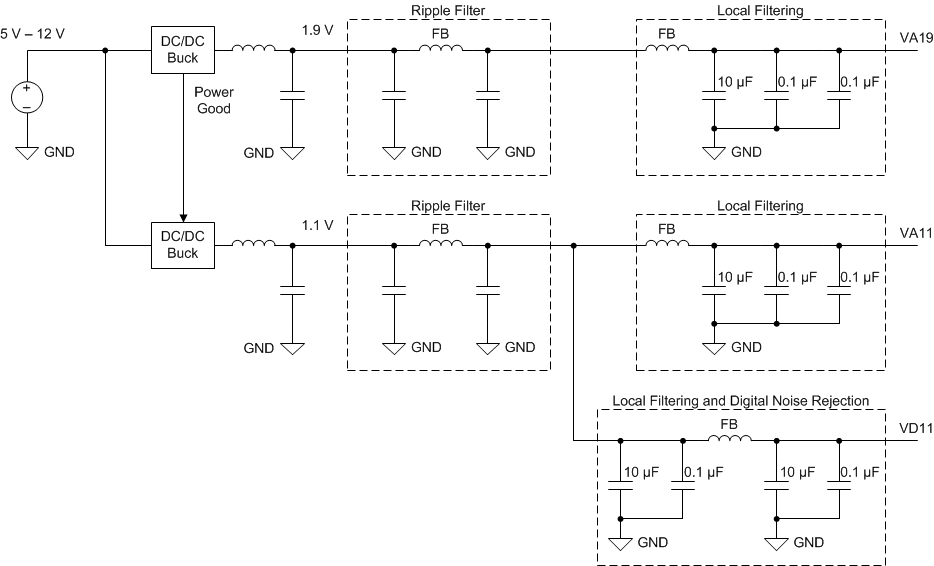JAJSGI4B November 2018 – March 2021 ADC12DJ3200QML-SP
PRODUCTION DATA
- 1 特長
- 2 アプリケーション
- 3 概要
- 4 Revision History
- 5 Pin Configuration and Functions
-
6 Specifications
- 6.1 Absolute Maximum Ratings
- 6.2 ESD Ratings
- 6.3 Recommended Operating Conditions
- 6.4 Thermal Information
- 6.5 Electrical Characteristics: DC Specifications
- 6.6 Electrical Characteristics: Power Consumption
- 6.7 Electrical Characteristics: AC Specifications (Dual-Channel Mode)
- 6.8 Electrical Characteristics: AC Specifications (Single-Channel Mode)
- 6.9 Timing Requirements
- 6.10 Switching Characteristics
- 6.11 Timing Diagrams
- 6.12 Typical Characteristics
-
7 Detailed Description
- 7.1 Overview
- 7.2 Functional Block Diagram
- 7.3
Feature Description
- 7.3.1 Analog Inputs
- 7.3.2 ADC Core
- 7.3.3 Timestamp
- 7.3.4 Clocking
- 7.3.5 Digital Down Converters (Dual-Channel Mode Only)
- 7.3.6 JESD204B Interface
- 7.3.7 Alarm Monitoring
- 7.3.8 Temperature Monitoring Diode
- 7.3.9 Analog Reference Voltage
- 7.4
Device Functional Modes
- 7.4.1 Dual-Channel Mode
- 7.4.2 Single-Channel Mode (DES Mode)
- 7.4.3 JESD204B Modes
- 7.4.4 Power-Down Modes
- 7.4.5 Test Modes
- 7.4.6 Calibration Modes and Trimming
- 7.4.7 Offset Calibration
- 7.4.8 Trimming
- 7.4.9 Offset Filtering
- 7.5 Programming
- 7.6 Register Maps
- 8 Application Information Disclaimer
- 9 Layout
- 10Device and Documentation Support
パッケージ・オプション
デバイスごとのパッケージ図は、PDF版データシートをご参照ください。
メカニカル・データ(パッケージ|ピン)
- ZMX|196
- NWE|196
サーマルパッド・メカニカル・データ
発注情報
9 Power Supply Recommendations
The device requires two different power-supply voltages. 1.9 V DC is required for the VA19 power bus and 1.1 V DC is required for the VA11 and VD11 power buses. The power-supply voltages must be low noise and provide the needed current to achieve rated device performance.
There are two recommended power supply architectures:
- Step down from the system voltage using high-efficiency DC/DC switching converters followed by a second stage of low-noise regulation by a low drop-out linear regulator (LDO). The LDO provides switching noise reduction, reduces passive filtering requirements and improves voltage accuracy if placed locally at the ADC.
- Directly step down from the system voltage to the final ADC supply voltages using high-efficiency DC/DC switching converters. This approach provides the best efficiency, but care must be taken to make sure switching noise is minimized to prevent degraded ADC performance. Additional passive filtering is required for best performance and any lossy series components may reduce the actual voltage at the ADC.
TI WEBENCH® Power Designer can be used to select and design the individual power supply elements needed: see the WEBENCH® Power Designer.
A recommended DC/DC switching regulator for the first stage is the TPS50601A-SP, but other similar devices can be used as well. Recommended LDOs for the second stage include TPS7H1101A-SP, TPS7A4501-SP and other similar devices.
For the switcher only approach, the ripple filter must be designed to provide sufficient filtering at the switching frequency of the DC-DC converter and it's harmonics. WEBENCH® reports the switching frequency when used to design the supply. Each application will have different tolerances for noise on the supply voltage so strict ripple requirements are not provided. Figure 9-1 and Figure 9-2 illustrate the two approaches.
 Figure 9-1 LDO Linear Regulator Example
Figure 9-1 LDO Linear Regulator Example Figure 9-2 DC/DC Switching Regulator Example
Figure 9-2 DC/DC Switching Regulator Example